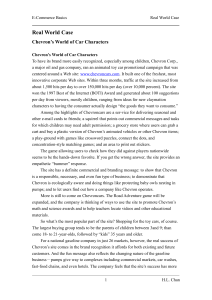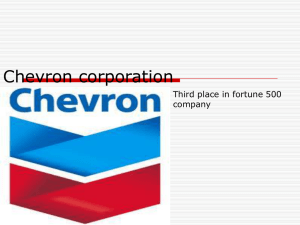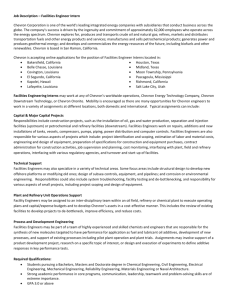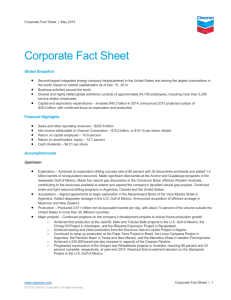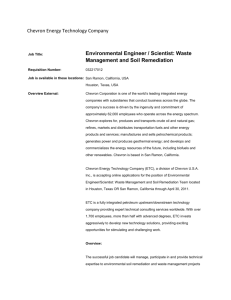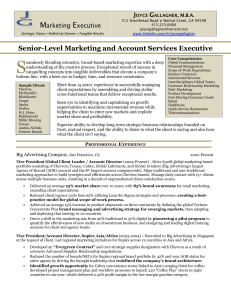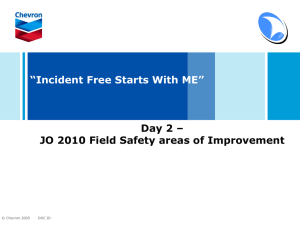Is the Stock Market About to Go Totally '90s?
advertisement
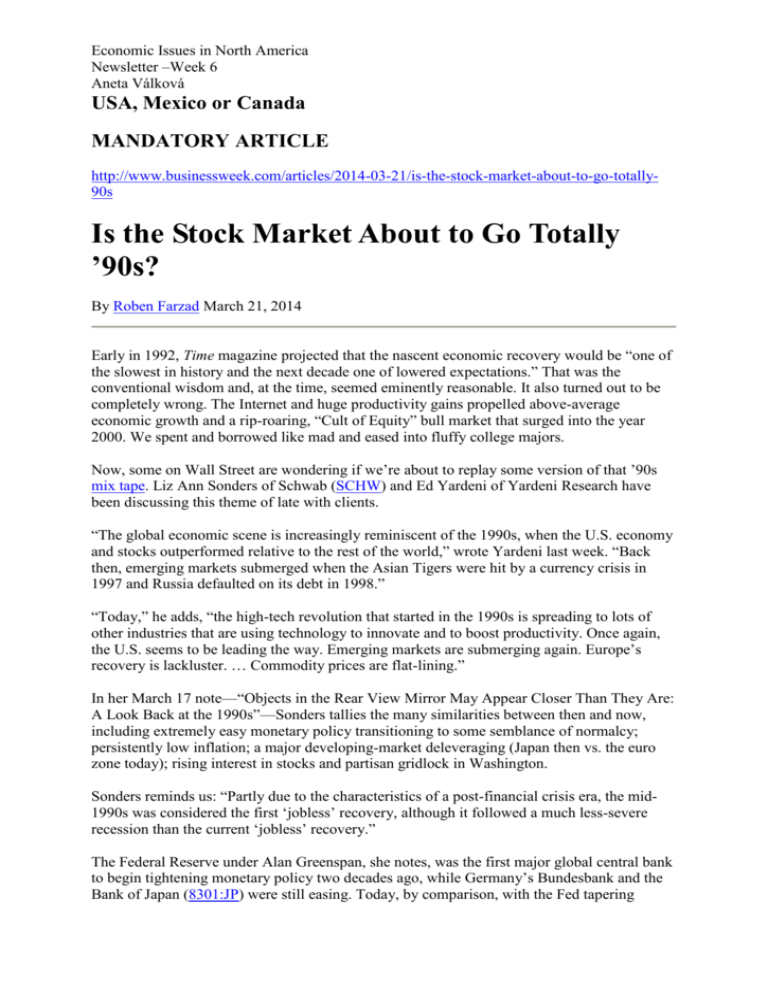
Economic Issues in North America Newsletter –Week 6 Aneta Válková USA, Mexico or Canada MANDATORY ARTICLE http://www.businessweek.com/articles/2014-03-21/is-the-stock-market-about-to-go-totally90s Is the Stock Market About to Go Totally ’90s? By Roben Farzad March 21, 2014 Early in 1992, Time magazine projected that the nascent economic recovery would be “one of the slowest in history and the next decade one of lowered expectations.” That was the conventional wisdom and, at the time, seemed eminently reasonable. It also turned out to be completely wrong. The Internet and huge productivity gains propelled above-average economic growth and a rip-roaring, “Cult of Equity” bull market that surged into the year 2000. We spent and borrowed like mad and eased into fluffy college majors. Now, some on Wall Street are wondering if we’re about to replay some version of that ’90s mix tape. Liz Ann Sonders of Schwab (SCHW) and Ed Yardeni of Yardeni Research have been discussing this theme of late with clients. “The global economic scene is increasingly reminiscent of the 1990s, when the U.S. economy and stocks outperformed relative to the rest of the world,” wrote Yardeni last week. “Back then, emerging markets submerged when the Asian Tigers were hit by a currency crisis in 1997 and Russia defaulted on its debt in 1998.” “Today,” he adds, “the high-tech revolution that started in the 1990s is spreading to lots of other industries that are using technology to innovate and to boost productivity. Once again, the U.S. seems to be leading the way. Emerging markets are submerging again. Europe’s recovery is lackluster. … Commodity prices are flat-lining.” In her March 17 note—“Objects in the Rear View Mirror May Appear Closer Than They Are: A Look Back at the 1990s”—Sonders tallies the many similarities between then and now, including extremely easy monetary policy transitioning to some semblance of normalcy; persistently low inflation; a major developing-market deleveraging (Japan then vs. the euro zone today); rising interest in stocks and partisan gridlock in Washington. Sonders reminds us: “Partly due to the characteristics of a post-financial crisis era, the mid1990s was considered the first ‘jobless’ recovery, although it followed a much less-severe recession than the current ‘jobless’ recovery.” The Federal Reserve under Alan Greenspan, she notes, was the first major global central bank to begin tightening monetary policy two decades ago, while Germany’s Bundesbank and the Bank of Japan (8301:JP) were still easing. Today, by comparison, with the Fed tapering Economic Issues in North America Newsletter –Week 6 Aneta Válková quantitative easing, the U.S. is again out in front of most other global central banks (save for the Bank of England)—all while inflation remains low with a muted risk of a spike-up from these levels, even if wage growth accelerates here (as it did in the mid-1990s). As for markets: As in the 1990s, shares in the U.S. have wrested leadership from out-of-favor emerging markets such as Russia, Brazil, and China. “Emerging markets,” observes Sonders, “are now facing long-term structural problems amid rolling currency crises; not all that dissimilar to the Asian currency crisis/Russian default/LTCM [Long-Term Capital Management] failure era of the late-1990s.” The U.S. market, which bottomed five years ago, appears to be in the first few innings of another stretch of outperformance to developing economies—in sharp contrast to the state of affairs during America’s lost market decade, the 2000s. The Schwab strategist further quotes a January report by the firm BCA Research to compare today’s deflationary euro zone to 1990s Japan: “In the first half of the 1990s, Japan was struggling with debt deflation. Economic growth in Japan fell apart, profits collapsed and the economy was marching toward sustained price deflation. … Today’s euro zone is yesterday’s Japan: excluding Germany, the rest of the euro zone economy remains mired in stagnation.” There are, of course, major differences between today’s backdrop and that of the early-to-mid 1990s. Never has the Fed thrown so much stimulus at an economic slowdown, the 2008-09 likes of which was more painful than anything seen since the 1930s. Today’s profit margins are unusually fat. Income inequality is worse. The giddy 1990s, moreover, set us up for the triple trauma of the following decade: the tech crash, Sept. 11, and then the housing collapse and Wall Street’s near-death experience. So, says Sonders, it stands to reason that a thricebitten skepticism stands in the way of a full 1990s redux. Is it really different this time? It should be remembered that then-Fed Chairman Greenspan gnomically warned of irrational exuberance three-plus years before that bubble hit peak swell. With that kind of lead time in mind, current rookie chief Janet Yellen might want to start drafting something equivalently indecipherable soonish. Q1: Do you agree with the opinion that current U.S. stock market (or if you like global stock market) resembles stock market in the 1990s? Q2: What major differences would you emphasize between the state of economy then (1990s) and now? Q3: Is it possible to compare economy of era when the Internet just started with that of contemporary high-tech era? International Economy http://www.nytimes.com/2014/03/24/business/international/us-official-lobbies-for-transatlantic-trade-pact.html?ref=international Economic Issues in North America Newsletter –Week 6 Aneta Válková U.S. Official Lobbies for Trans-Atlantic Trade Pact By JAMES KANTERMARCH 23, 2014 BRUSSELS — Completing a landmark trans-Atlantic trade agreement could help Europe wean itself from reliance on Russian energy supplies, the United States trade representative, Michael Froman, has said. Mr. Froman made his comments here on Saturday before a visit by President Obama that is scheduled to start on Tuesday evening, with a summit meeting of European Union and United States officials set for the following day. The Transatlantic Trade and Investment Partnership, now being negotiated, is among the items Mr. Obama is set to discuss with Herman Van Rompuy and José Manuel Barroso, the union’s top officials. Mr. Obama’s visit, scheduled before the crisis erupted in Crimea, will be his first to Brussels since he took office. Energy is expected to be a key topic at the meeting because of the heightened tensions with Russia. Russia has cut natural gas supplies to Europe a number of times in the past decade during disputes with Ukraine and other transshipment countries, prompting severe shortages in parts of the union. Encouraging the export of American natural gas to Europe “is yet another rationale for completing” the trade talks, Mr. Froman told the Brussels Forum, a conference organized by the German Marshall Fund of the United States. Mr. Froman suggested that if a far-reaching trade agreement were in place, it would be a good deal easier for the Department of Energy to grant licenses to companies wishing to export shale gas from the United States. “If you’re a free trade agreement country, those licenses are deemed to be in the public interest,” Mr. Froman said during a panel discussion with the European Union trade commissioner, Karel De Gucht. Earlier on Saturday, Mr. Froman told reporters that “recent developments just underscore the importance of the trans-Atlantic relationship,” adding, “From both a strategic and economic perspective, the rationale for the T.T.I.P. could never be stronger.” Although European and American officials trumpet the importance of the trans-Atlantic alliance, there are thorny elements in the relationship. The last time the two sides held a similar meeting, in Washington in November 2011, the United States was concerned that European leaders’ insistence on austerity was a threat to the global economy. More recently, relations were soured by National Security Agency spying, including tapping of the cellphone of the German chancellor, Angela Merkel. The start of negotiations for a trade deal was announced with great fanfare last year, and European officials, eager to find ways of stoking confidence in the region’s beleaguered economy, expressed optimism about reaching an agreement by 2015. Since then, in the course Economic Issues in North America Newsletter –Week 6 Aneta Válková of four rounds of talks in Brussels and Washington, progress has been slower than many officials had hoped. There are widespread concerns among Europeans that any agreement with the United States would jeopardize environmental and food safety standards. Some American companies are concerned that protections for investors will not be part of a deal. Even in the relatively straightforward area of tariff reductions, the two sides have yet to reach agreement on how various industrial sectors should be treated. Another round of talks is expected to be held in Washington before summer. There are many companies willing to export American natural gas. There also is demand in union member countries like Poland and Lithuania for American energy as part of efforts to break their reliance on Russian sources. Russia currently supplies about a quarter of the union’s natural gas needs, but some former members of the Soviet bloc are almost entirely dependent on Russian energy. Yet a number of American manufacturers doubt the wisdom of the United States’ exporting cheap shale gas. “We’re not trying to block anything,” Heinz Haller, president of Dow Europe, Middle East and Africa, told a separate panel at the Brussels Forum. But he suggested that exporting shale gas could raise American energy prices at a time when “the U.S. needs to repatriate a lot of industry.” “There is nobody who is saying we should not have free trade in this, but only when it makes economic sense,” Mr. Haller said. Even so, there are 28 gas export permits awaiting approval by the Department of Energy. Approvals typically take three or four months, according to Nelson W. Cunningham, a former White House adviser who now is president of McLarty Associates, a consulting firm whose clients include energy companies. In an interview, Mr. Cunningham said that even without a trans-Atlantic trade pact in place, export approvals should be accelerated to help Eastern Europe secure non-Russian sources of energy. He said the United States authorities should consider allowing companies “to jump the queue” for export licenses if they could show the gas would go to Eastern Europe. Q1: Do you think that current political development in Ukraine will help to accelerate negotiations concerning the Trans-Atlantic Trade Agreement? Q2: Is the nature of the U.S. interest in the trade pact more political or economic? Can such agreement be beneficial for the U.S. economically? Economic Issues in North America Newsletter –Week 6 Aneta Válková An Economic Sector http://www.ft.com/intl/cms/s/0/5ff0a564-b36c-11e3-bc21-00144feabdc0.html#slide0 Last updated: March 24, 2014 8:23 pm Bullish Chevron to outspend Exxon By Ed Crooks Economic Issues in North America Newsletter –Week 6 Aneta Válková Beacon of light: although Chevron ranks second to Exxon in the US in terms of market capitalisation, the oil major is planning to outspend its larger rival in a bet on the continuing high oil price ©Reuters Chevron has long been overshadowed by its larger rival ExxonMobil. Next year, however, it will overtake Exxon on one important measure: capital and exploration spending. This is striking because Exxon is so much bigger: it produces 54 per cent more oil and gas than Chevron and its market capitalisation is 85 per cent bigger. The fact that Chevron is nevertheless planning to invest more than Exxon shows how sharply the companies’ strategies have diverged. Exxon is aiming for stability, while Chevron is going for growth. Chevron is planning to invest about $40bn per year in 2014-16: slightly less than the $42bn it reported for 2013. Exxon is cutting its spending more sharply, from $42.5bn last year to about $40bn this year, and then an average of less than $37bn per year in 2015-17. George Kirkland, Chevron’s vice-chairman and head of exploration and production, says the disparity reflects the two companies’ differing production profiles. Exxon produced an average of about 4.18m barrels of oil equivalent per day in 2013, and expects to produce 4.3m boe/d in 2017: an increase of about 3 per cent. Chevron produced 2.6m boe/d last year, and is targeting 3.1m boe/d in 2017: an increase of 19 per cent. “That 500,000 barrels per day is huge growth, and the capital spending is what gets us there,” Mr Kirkland told the Financial Times. Chevron is investing heavily to complete projects including Gorgon and Wheatstone, its two large liquefied natural gas plants in Australia. Costs have soared at both, but Gorgon is 78 per Economic Issues in North America Newsletter –Week 6 Aneta Válková cent complete and Wheatstone 30 per cent. It also has two large projects coming on stream in the Gulf of Mexico: Jack/St Malo this year and Big Foot next. Exxon also has new projects coming into production, including Papua New Guinea LNG and an expansion at the Sakhalin 1 oilfield off the far east coast of Russia. It has more starting up in 2014 than in any year in its history. Yet all those projects will do little more than offset the decline of its mature fields and the loss of its share in the foreign companies’ oil concession in Abu Dhabi, which expired in January. In part, the difference is a sign that Chevron has had better investment opportunities. It has been highly successful with its exploration, particularly in the Gulf of Mexico, generating a flow of discoveries to bring into production over the next few years. It also earns more from its production, with the highest earnings per barrel of any large international oil company, in part because it has a higher proportion of its production in more lucrative oil and in LNG sold on oil-linked contracts. Beyond these operational differences, there is also a difference of approach. Chevron’s more ambitious investment plan is rooted in a fundamentally positive view of the oil price, based on Economic Issues in North America Newsletter –Week 6 Aneta Válková rising costs, decline in mature fields, and growing global demand. As John Watson, its chief executive, put it, the company is “bullish on oil”. The costliest oil extraction needed prices of about $100 per barrel, he said, and there were “a lot of barrels today that would be in pretty desperate shape at lower prices”. Exxon, by contrast, sounds much more cautious. Speaking to analysts in New York this month, Rex Tillerson, its chief executive, repeatedly stressed what he called its “disciplined capital allocation”. Mr Kirkland draws a contrast between oil and gas. “Oil is a much more mature resource in terms of what’s been produced than gas,” he said, adding that perhaps 40-50 per cent of the world’s endowment of oil, excluding the latest shale oil discoveries, had already been extracted. That meant being selective about the investment projects that Exxon chose to approve, he said. “What really governs the level of investment programmes is the quality of the opportunities that are offered to us, and our judgment around our ability to execute them well.” He refused to make any prediction about prices, even in the most general terms. But speaking about the prospects for negotiations with governments in resource-rich countries, his tone was very different from Mr Watson’s. The world was in an “era of abundance”, he said. “There is a lot of resource coming on the market out there.” The implication is that Exxon sees a higher chance of weaker oil prices than Chevron does and, having committed less to production growth, it will be better positioned to prosper in that environment. In the past year, as the US oil boom has put downward pressure on oil prices, and raised the prospect of further falls, investors have clearly preferred Exxon’s approach. Over the past five years it has lagged behind Chevron, but on a 12-month view its shares have been outperforming, rising by 6 per cent while Chevron’s have dropped 5 per cent. The decision last year by Warren Buffett’s Berkshire Hathaway to buy 40m Exxon shares, now worth about $3.77bn, was a vote of confidence in its more cautious stance. Brian Youngberg, an analyst at Edward Jones, says investors have become increasingly concerned about rising costs hurting oil companies’ profits. “Royal Dutch Shell and others are seeing the rate of return on every dollar they invest continuing to go down. So companies are telling investors they are not going to invest more, but will bump up the dividend or have share buybacks instead,” he says. “If oil prices pull back then not investing might turn out to have been the best decision.” The shale revolution is still in its early stages, however, and the extent and duration of its impact on world markets have yet to be fully tested. Chevron is making some very big bets on its bullish view of prices, and will be well rewarded if it is proved right. Economic Issues in North America Newsletter –Week 6 Aneta Válková Exxon and Chevron share vision on shale One subject that ExxonMobil and Chevron agree on is the promise of US onshore oil production, particularly in “unconventional” reserves such as shale. Having been slow to pick up on the potential of shale oil, which was first exploited by smaller companies such as EOG Resources and Continental Resources, both Exxon and Chevron are stepping up investment, and are enthusiastic about its potential for growth. Chevron is focusing on the Permian basin of west Texas. George Kirkland, its vice-chairman, says the expansion it plans there is “like a really big major capital project”. Chevron’s production in the region last year was about 135,000 barrels of oil equivalent per day; it expects to reach 250,000 boe/d by 2020. At large projects, such as the deep water oilfields that are Chevron’s speciality, the costs of exploration, development and construction last for many years, and then the revenues come “in a big rush” when the well starts producing. In shale, the individual wells take days to drill, but production drops off quickly from each hole, so more have to be drilled to sustain output. Nevertheless, Mr Kirkland says, “the costs aren’t bad” and the revenues are realised more quickly. Exxon likewise is aiming at rapid growth in US oil production. It picked up substantial gas assets when it bought XTO Energy, a shale producer, in 2010, but has been shifting drilling rigs to pursue oil instead, in the Bakken shale of North Dakota, the Woodford Ardmore shale of Oklahoma, and the Permian basin. It plans to increase production in those three areas from 85,000 barrels of oil per day in 2010 to 225,000 b/d in 2017. Q1: Is Exxon’s strategy of “disciplined capital allocation” wiser in current oil market context? Q2: Do you think that Chevron can lose more than gain due to its high investments? Is it better to aim at stability or at growth?
